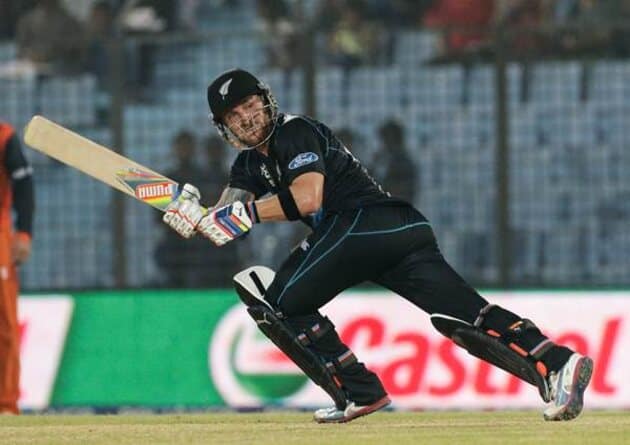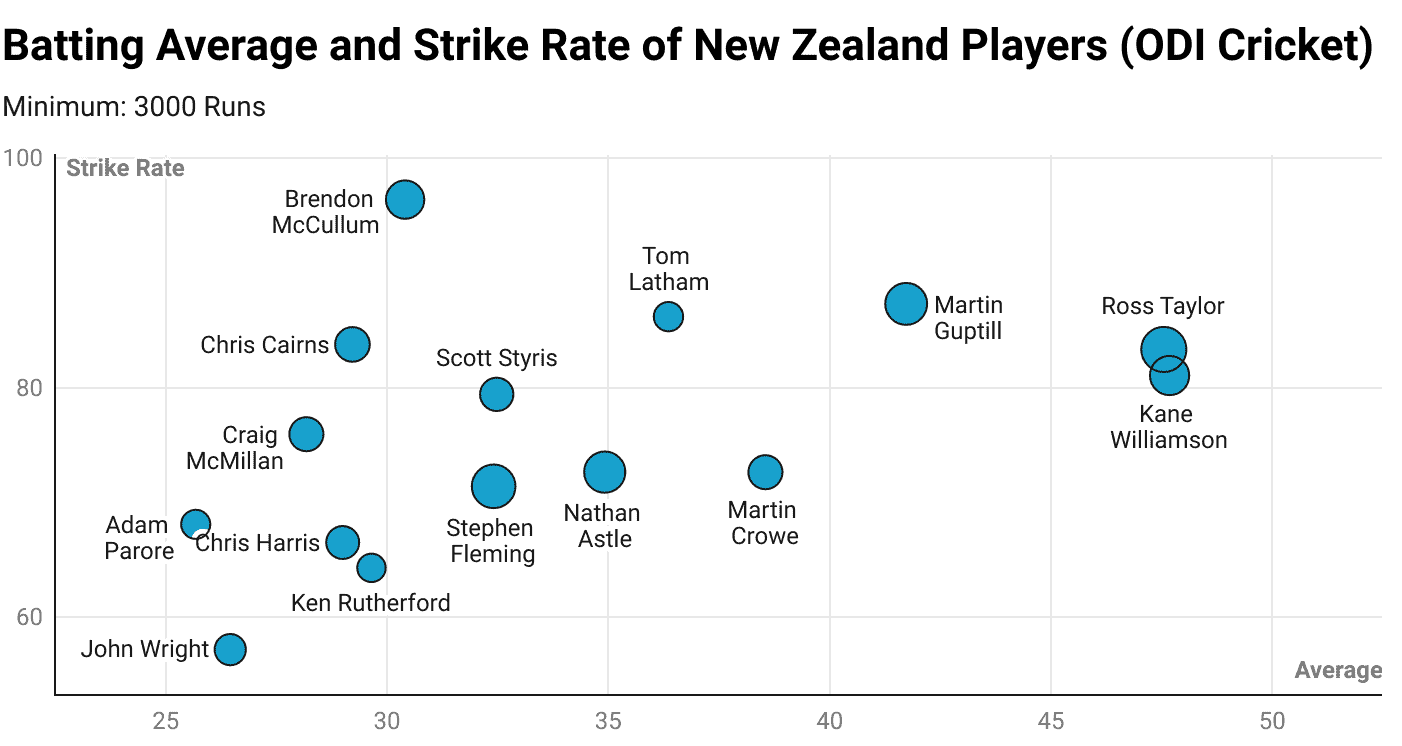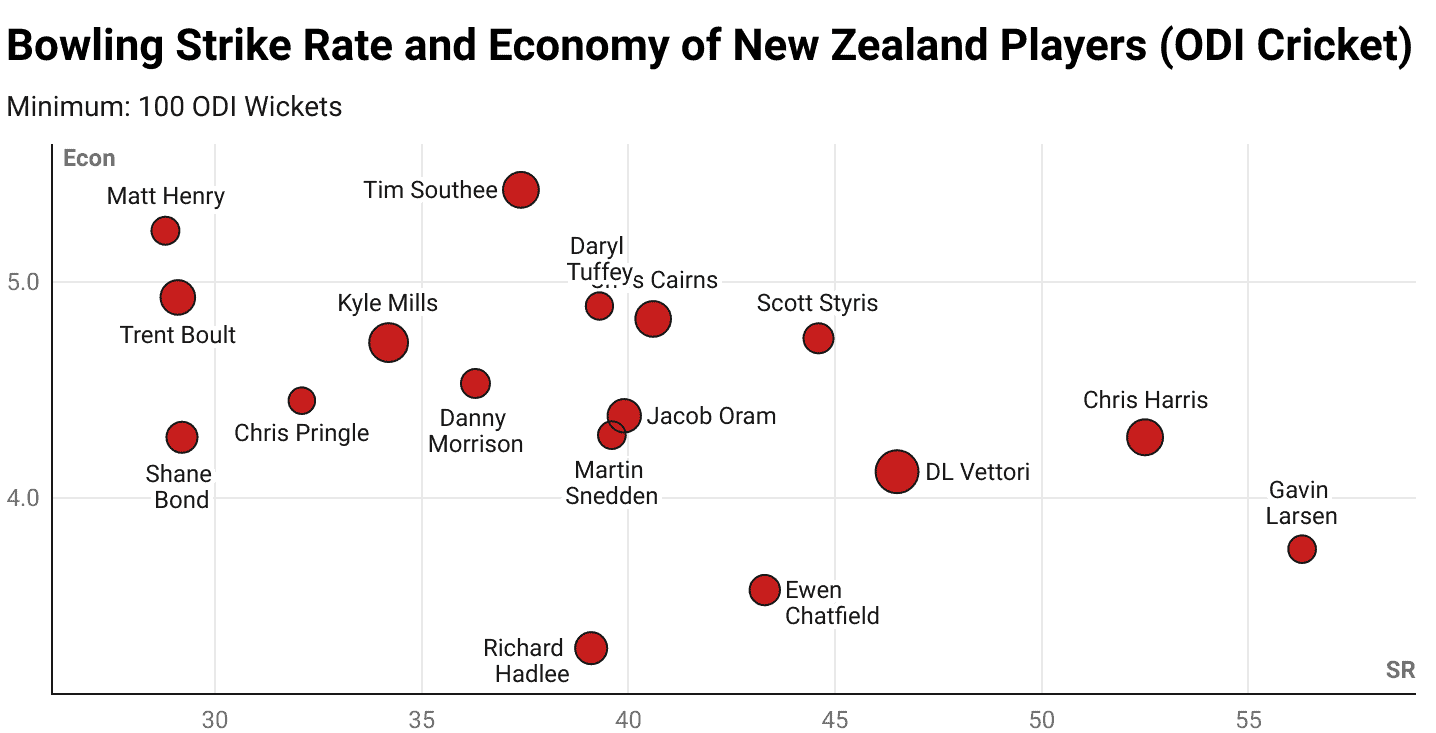The country of New Zealand has a population of a little over 5.2 million, but they always manage to punch above their weight consistently in ICC tournaments.
They had a rough start to their international cricket Journey, with their first victory coming nearly 40 years after their first international match, however, their start to One-Day internationals was much more pleasant full.
They made it to the Semis of the initial two Cricket World Cups (then known as the Prudential Cup) on the back of their first Cricketing Superstar, Glenn Turner. However, the 80s were rough with Richard Hadlee often bailing the island nation out of trouble. The 90s were an all-time low for the Kiwi’s white-ball side, enduring a W/L ratio of 0.695.
The 2000s were an upgrade with Kiwis producing world-class players such as Stephen Fleming, Scott Styris, and Chris Cairns. It was during this period that New Zealand would win their only ICC white ball trophy, the 2000 Champions trophy. The 2010s would be the best period for New Zealand Cricket, with New Zealand making it to 2 finals and 1 semi Final in three consecutive ODI world cups, and currently, the team is growing from strength to strength, possessing one of the best bowling attacks in the World.
Well so as to honor the various ODI stalwarts from this island nation, Clan For Gamers presents to you the New Zealand All Time ODI XI.
Martin Guptill
Martin Guptill is an easy choice for the first opener spot. A phenomenal fielder, Martin Guptill has been one of the most consistent white ball performers of this generation, being the 6th highest run-getter in ODIs since 01 Jan 2010.
- Innings: 174
- Runs: 7346
- Average: 41.74
- Strike Rate: 87.3
A hard-hitting batsman, Guptill has the ability to play long innings, evidenced by his Daddy Hundreds such as 180* against South Africa, 189* against England, and 237* in the World Cup quarter-finals against the Windies.
His partnership with Brendon Mccullum at the top is one of the most iconic opening pairs of all time, yielding 1904 runs at an average of 42.31 with a run rate of 6.59
Brendon McCullum (WK) (C)
The 5’7″ pocket dynamite is one of the most influential figures in New Zealand Cricket history.
McCullum made his ODI debut as an opener but would be moved down the order after just 4 matches. He didn’t make a return to the position until 4 years later, and he would make the position his own, with his approach being to make the most out of the batting powerplay.
- Innings: 107 (As Opener)
- Runs: 3,363
- Batting Average: 32.97
- Strike Rate: 102.75
Brendon’s strike rate of 102.75 as an opener is the 4th highest (min. 2000 runs). Moreover, he was a great keeper too, as proved by his records across formats, and thus in this eleven, he dons the gloves too.
- Matches: 260
- Catches/Stumpings: 227/15
- Dismissals Per Match Ratio: 0.93
He was a revolutionary leader, boasting a win percentage of 57.38, the best among all the terrific leaders New Zealand has had over the years. Thus he would lead his Nation once again over here.
Potential Picks For Opening Slot: Glenn Turner, Nathan Astle.
New Zealand had a few great cricketers in the past such as Bert Sutcliffe and Jack Cowie, but the winning culture was cultivated by Turner. A whole separate article can be written for this underrated legend of the game, but we would keep the discussion limited to ODIs.
Glenn Turner’s numbers adjusted in Rohit Sharma’s Era are as follows:
Batting Average: 57.587
Strike Rate: 93.09
In Case You don’t know, how these Adjusted Numbers are calculated, You can read our article on Greatest ODI Openers of All Time, where we use/explained this metric.
These are Kohliesque numbers but his sample space as an opener is way too small, comprising just 29 innings, which included a 140 against Sri Lanka and a 171* against East Africa.
Nathan Astle was a good potential pick, having over 6,000 runs as an opener, but the gigantic difference between the strike rate of his and McCullum, along with McCullum’s keeping and captaincy traits, meant Astle couldn’t make the cut.
Kane Williamson
If McCullum was the fire that New Zealand Cricket required to compete with the best in the world, Kane is the Ice that has kept the New Zealand ship steady ever since his departure. Traditionally the Kiwi batsmen have found the transition between home and away games much tougher compared to the rest of the world, but Kane is one anomaly here, with his average boosting up from 44.09 to 49.88 in home vs away matches, respectively.
- Innings: 148
- Runs: 6,296
- Batting Average: 46.99
- Strike Rate: 80.86
Kane is also the odd sheep out when it comes to Kiwi batsmen at ICC tournaments.
Across the World Cup and the Champions/Knockout trophy, Kane averages 59.80 with a strike rate of 81.55.
Martin Crowe
A strong-willed determined visionary, these qualities were reflected in Crowe’s batting too.
One of the few players who was able to counter the art of reverse swing in that era, Crowe was always in the outlook for fresh ideas to elevate both his own game and New Zealand’s cricketing status. There is a reason why Wasim Akram rated him as the hardest batsman he bowled to.
- Innings: 140
- Runs: 4,704
- Average: 38.56
- Strike Rate: 72.63
An astute cricketer, Crowe was the only batsman in the NZ line-up of that era, who could compete with the best in the world.
His influence on his team’s performance can be obtained from his record in Wins vs Losses:
In wins: Matches: 61 Runs: 2694 Average: 59.86 Strike Rate: 79.02
In losses: Matches: 78 Runs: 1938 Average: 25.84 Strike Rate: 64.49
Crowe was also phenomenal when it came to performing on the big stage. He has scored 880 runs @55 by striking at 83.49
Ross Taylor
The man with the most ODI runs for New Zealand, Ross Taylor had been one of the most consistent performers of this generation. His numbers in the 2010s are only behind Virat Kohli and Ab de Villiers.
Taylor averaged over 40 in 11 out of the 15 years of his career (min. 3 matches).
To complement his consistency, Taylor could accelerate at a brisk rate, proof of this being his innings against Pakistan at the 2011 World Cup or his 4 ODI Hundreds at a strike rate greater than 120!
- Innings: 220
- Runs: 8,607
- Average: 47.55
- Strike Rate: 83.22
Taylor’s favorite position was the number 4, However, we also had to accommodate Martin Crowe in this team, and thus Taylor finds himself at 5, a position whose required skill set had been available in Taylor’s game.
Potential Picks for Middle Order Batsman: Stephen Fleming, Scott Styris
Stephen Fleming is the second-highest run-getter for New Zealand in ODIs and also the second most-capped kiwi player, but his batting pedigree is just not enough to dislodge any of the above-mentioned 3 individuals.
Scott Styris makes a good case for the number 5 position in the team. He has played 46 innings at this position, possesses a phenomenal World Cup record, and also has 137 wickets to his name.
However Taylor and Crowe were just too good with the bat for Scottie to replace them solely on the basis of that discipline, and we have enough bowling in this team so as to not miss Styris’ handy medium pacers.
Chris Cairns
Son of former cricketer Lance Cairns, Chris sure did leave his old man behind when it came to building cricketing legacies.
He would often open the bowling for New Zealand, troubling the opposition with his inswingers, and would later come back into the action, this time with the bat, hitting the ball long and hard. It’s tough to categorize Cairns as a bowling or a batting all-rounder, as he was equally good in both disciplines.
- Matches: 215
- Runs: 4,950
- Batting Average: 29.46
- Batting Strike Rate: 84.37
- Wickets: 201
- Bowling Average: 32.81
- Bowling Strike Rate: 40.64
- Economy: 4.84
Cairns is the 4th highest wicket-taker and the 7th highest run-getter for New Zealand in ODIs. Even though things went sour for him by the end of his career, all Kiwi fans still hold fond memories of his century in the 2000 Knockout Trophy Finals.
Jacob Oram
Jacob Oram is arguably the most undervalued player on this team. A player who was well equiped in both disciplines, Oram possesses Man of the Match awards for sole performances in both departments
- Matches: 116
- Runs: 2,434
- Batting Average: 24.10
- Batting Strike Rate: 86.62
- Wickets: 173
- Bowling Average: 29.17
- Bowling Strike Rate: 39.95
- Economy: 4.38
Oram didn’t have the best of starts; he floated around the batting order and did not get enough time with the ball. However, he would eventually grow into this role, playing an important role in New Zealand’s success in ICC tournaments.
Oram specifically stepped up with the ball in pressure situations. He picked up 51 wickets @20.35 with a strike rate of 29 and economy of 4.20 in ICC tournaments.
Potential picks for Lower Order Batsman/All-Rounders: Chris Harris, Lance Cairns
Chris Harris had a long career for New Zealand, currently the 4th most capped player for New Zealand and their 3rd highest wicket-taker. However, a strike rate of 66.52 meant Harris was not able to make it into the lower order.
Lance Cairns is one of the few players, whose cricketing career has been overshadowed by his offspring, but Lance was no less dangerous with the bat. A Strike rate of 104.89 in that era(1974-85) translates to 134.5 in the 2010s, however, a bowling average of 30.53 translates to 34.63 in the same period.
Thus his below-average bowling and a career spanning only 78 matches meant Lance couldn’t find a spot alongside Chris in this team.
Richard Hadlee
Hadlee’s test career overshadows his ODI exploits, but Hadlee was one of his generation’s best white ball bowlers.
According to Z-Factor, Hadlee’s numbers in the 2010s would have been:
- Average: 23.399
- Economy: 4.15
- Strike Rate: 33.80
To get an idea about the method of adjusted numbers, you can take the help of our article on the Z Factor/Era Ajudusted Numbers.
Thus an argument that Hadlee bowled in an easier era, doesn’t really work. Like Martin Crowe, Hadlee was immensely influential in his team’s performances, his bowling average jumping from 16.32 to 28.52 in wins vs losses, respectively.
- Matches: 115
- Wickets: 158
- Bowling Average: 21.56
- Bowling Strike Rate: 3.31
- Economy: 39.13
- Runs: 1,751
- Batting Average: 21.62
- Batting Strike Rate: 75.51
Conditions weren’t a factor when it came to Hadlee’s performances, with him averaging 21.96 with the ball away from home.
Hadlee was one of the biggest match-winner cricket has seen as he won a man of the match award per 11.5 ODI matches played. This is a phenomenal record, considering Man of the Match became a norm in the 80s, 7 years into Hadlee’s career.
Moreover, Hadlee had been much more than a handy batsman, winning 2 man of the match awards, solely for his batting.
Daniel Vettori
The highest-capped kiwi with the most wickets for New Zealand had to make the team. Though his bowling numbers aren’t really flattering, Vettori is by far the greatest spinner New Zealand has produced.
Standing at 6’3″, Vettori’s strength was his ability to flight the ball and extract bounce from the surface. He wasn’t a big spinner of the ball and this perhaps explains his rather dull record in India and Pakistan.
- Innings: 277
- Wickets: 305
- Average: 31.72
- Strike Rate: 46.10
- Economy: 4.13
Vettori’s numbers take a hit due to his pathetic performance against the two best teams of his career, South Africa and Australia. He averaged 50.24 and 40.71 against them, respectively, and played 33.5% of his career matches against them.
Removing these games, his bowling average boosts up to 27.57.
Moreover, he has over 2,000 career runs at an average of 17.33. Therefore, Vettori will also have an important role in the lower order along with Hadlee.
Trent Boult
New Zealand has been the 2nd best bowling side for the last 10 years, and one of the primary reasons is Boult.
Since his debut in July 2012, Boult has been the second highest-wicket taker with the 5th best bowling average(min. 100 wickets).
- Innings: 99
- Wickets: 187
- Average: 23.98
- Strike Rate: 29.16
- Economy: 4.93
This shows how important Boult has been in New Zealand’s success in recent times.
He doesn’t let this performance drop in ICC tournaments, where he has picked up 42 wickets at an average of 23.38 at a strike rate of 29.7.
His share in the team’s total wickets is a staggering 24.13%, 7th highest for bowlers with 30 innings or more.
Shane Bond
Despite playing only 82 matches, Shane Bond is considered to be the greatest Kiwi ODI bowler of all time. Well, we certainly can’t dispute that statement.
During Bond’s career, only Glenn McGrath had more wickets at a better average.
Much like his predecessor Hadlee, Bond was a big influence in New Zealand’s victories, possessing the 8th-best average in Wins(16.67).
Batters such as Sangakkara, Ponting, and Tendulkar averaged 31,10, and 4 against Bond.
- Innings: 80
- Wickets: 147
- Average: 20.88
- Strike Rate: 29.22
- Economy: 4.29
His extreme pace coupled with his Toe-crushing yorkers made him highly effective across conditions.
Bond was also lethal in ICC tournaments, picking up 32% of his total wickets at an average of 21.06.
Potential Picks for Fast Bowlers: Chris Pringle, Matt Henry, Kyle Mills
Matt Henry and Chris Pringle were both ranked among the top 5 in the ICC rankings during their prime, however, both of them have under 65 ODI matches under their belt, thus keeping them out of this side.
Boult vs Mills was the most difficult choice we had to make while assembling this team.
On the surface, Boult’s career average of 23.98 seems to settle the debate when compared to Mills’ 27.02. However Mills outscores Boult when it comes to performance away from home, 24.66 vs 28.06, respectively.
Mills also outshines Boult when it comes to ICC tournaments, well for that matter, Mills outshines most other bowlers when it comes to this filter.
Only Mitchell Starc has picked up more wickets in ICC tournaments at a better average than Mills(34 at 17.32)
However, Boult does have a better well-rounded record, besides that Kyle also needs to thank Bangladesh for the better away record, picking up 14.37% of his away wickets, against the Bangla lions.
Mills would have surely made this team ahead of Vettori, but a lack of quality spinner meant, we had to pick Vettori so as to have a balanced bowling attack.
So New Zealand All Time ODI XI is
- Martin Guptill
- Brendon McCullum (wk) (c)
- Kane Williamson
- Martin Crowe
- Ross Taylor
- Chris Cairns
- Jacob Oram
- Richard Hadlee
- Daniel Vettori
- Trent Boult
- Shane Bond
12th man: Kyle Mills
Extras: Stephen Fleming, Glenn Turner, Scott Styris



